From the
Quisqualis website
by Bob G. Cannon II
Synsepalum dulcificum
Up Close & Personal
Plant Data:
SAPOTACEAE - Synsepalum
dulcificum Daniell
Miraculous Berry, Miracle Fruit
Miracle Fruit is native to Africa
Some
flowers are so small that it becomes difficult to see just how they are
arranged and where even some of the major parts are located. Miracle
fruit is one of these. I have been around these plants for decades and
never taken a really close look at the flowers. Recent discussions on a
rare fruit mail group I founded prompted me to take a good look at
these small flowers.
How is this fruit pollinated? Some
references exist that say it is ‘self pollinated’ and I
found none showing insect or animal pollination. The shape of the
flower, and the fact that many of them face downwards, suggests gravity
as a mechanism.
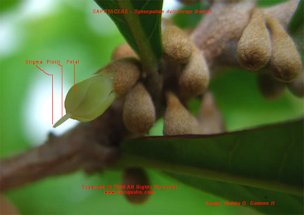
Fig. 1 
The
flowers are quite small and it was with some difficulty that I managed
to dissect some of the parts away from the flowers. I first tried
unopened flower buds but the parts seemed fused too tightly for a good
examination. Older flowers, where the petals have darkened, were too
dry and friable for much success. Flowers that were still at the stages
where the petals are cream or white offered the best results.
Since
I have seen evidence of pollen drop when working around the flowers I
collected some by holding a microscope slide beneath clusters of opened
flowers and giving the plant a few sharp taps. The grains are
translucent white and shaped somewhat like a coffee bean.
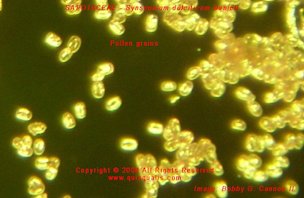
Fig. 2 
Objective: 4 (0.15)

Fig. 3 
Objective: 4 (0.15); 10 (0.25)
I
wanted a look at the source of this pollen so I opened flowers and
searched till I found the stamens and could see how they were attached.
In this image you can see on the right that the filament is attached to
the base of a petal. (The petals are somewhat spatulate in shape).
Stamens

Fig. 4 
Here is an image of an anther, much closer up.
Another
close-up
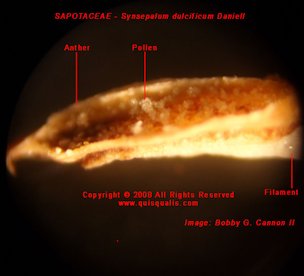
Fig. 5 
Objective: 4 (0.15)
Male
parts of the flower revealed I took a look at the female parts. You may
have noticed in one of the images of an entire flower that part of the
pistil and the stigma grow past the opening of the flower.
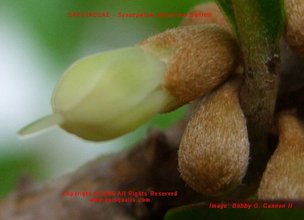
Fig. 6 
It
is this form of growth that suggests gravity as a major method of
pollination to me. Here is a micro photograph of the exposed stigma
where you can see the tip where pollen is received. You can also see
that the tip is not just a rounded surface but has several crenelations.
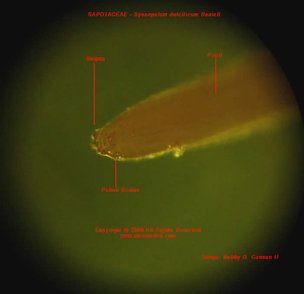
Fig. 7 
Objective: 4 (0.15)
This
image shows the base of the style where it attaches to the ovary. I
found it interesting that the ovary is quite pubescent at this point.
What function this serves is unknown to me but it might serve to repel
insects that would feed on the developing fruit.

Fig. 8 
Objective: 4 (0.15)
I was unable to get an image of the seed developing in the ovary and
will attempt to improve all images in a future update.
Producing
these images, as noted, was not easy and I have concluded that I need
to add some things to my micro photography set up: better dissection
tools; a more secure camera to microscope mount; new stage for
microscope (the one I have is missing some components); a lower power
dissecting microscope.
Microscope: Swift Nine Fifty Series. Objectives, Quad Phase: 4 (0.15);
10 (0.25); 40 (0.65); Eyepiece X20.
Images captured with a Samsung S850, 8.1 Mega Pixel digital camera.
Camera joined to microscope using an armstrong method.
Back to
Miracle Fruit Page
|
|
Bibliography
Cannon II, Bob. G. "Synsepalum
dulcificum Up Close and Personnal." Quisqualis Rare Fruit, Tropical Fruit and Rare Plant Information, 1992,
2006, www.quisqualis.com. Accessed 1 Mar. 2015.
Photographs
Fig. 1,2,3,4,5,6,7,8 Cannon II, Bob.
G. "Miracle
Fruit Flowers and Fruit." Quisqualis Rare
Fruit, Tropical Fruit and Rare Plant Information, 2008, www.quisqualis.com. Accessed 31 Mar. 2015.
Published 31 Mar. 2015 LR
|








